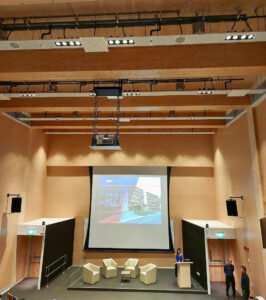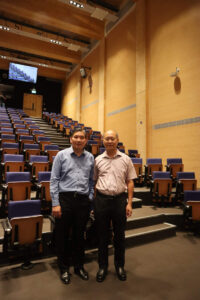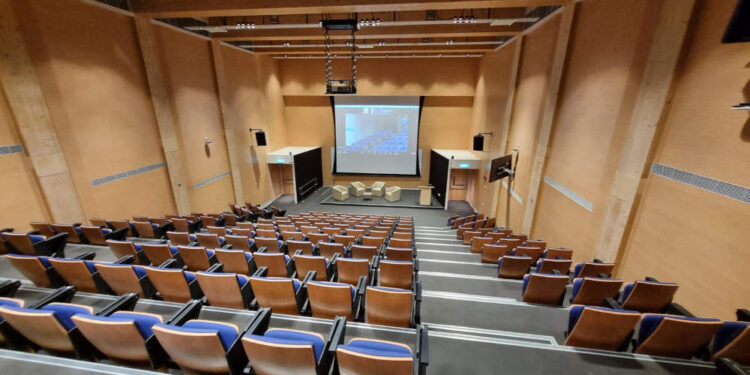Nanyang Business School integrates ceiling microphones to transform tiered-seating auditorium into a hybrid venue that caters to both attendees and presenters
A research-driven university, Nanyang Technological University (NTU) has consistently been ranked among the world’s top learning institutions. Adding to the education accolades, the newly launched six-storey building named GAIA, which houses the Nanyang Business School, one of the more established Schools providing comprehensive business and management education, also takes pride as a zero-energy building adding to the university’s commitment to sustainability.
GAIA is a mass-engineered-timber (MET) structure with teaching spaces on the first through third floors, a research centre on the fourth, faculty offices on the fifth through sixth floors, and a one-storey M&E ancillary block. A highly renewable material, MET contributes positively to environmental sustainability. Furthermore, MET is more manageable than steel and concrete due to its high strength-to-weight ratio. The building has a simple and efficient modular timber frame system approximately 220m long. The construction time and workforce required were significantly reduced since the MET components can be prefabricated off-site and assembled on-site. In this space, the Nanyang Business School offers undergraduate and graduate programmes and non-degree executive courses.
The school also wanted to provide hybrid learning opportunities for its diverse student cohort; and also optimise the space for hybrid events, allowing in-person and online engagement. As such, Joe Chan, facilities manager at NTU, was tasked with transforming the auditorium into an effective hybrid space.
“It is important that the experience for all participants attending the lessons and events in-person and those attending remotely would have an all-encompassing experience,” explained Joe Chan. “This would certainly enhance the experience for all.”
The hybrid system enables the seamless integration of remote speakers and attendees, making it easier than ever to connect and enable a consummate engagement for participants on-site and from around the world.
To achieve this experience, NTU put out a tender and awarded the project to AV Media. Key objectives to be met included:
• Ensuring seamless communication between the instructor/presenter and the in-person and online attendees at the auditorium. Speech clarity for the instructors/presenters and their students/attendees was crucial to achieving this aspect of the brief.
• Additionally, preserving the presenter’s audio and video quality was paramount since all presentations and lectures are recorded to facilitate on-demand requests.
AV Media was confident that they would meet the school’s objectives, with a spokesperson from AV Media noting, “We immediately recognised that ceiling microphones would be ideal for this project.”
The Challenge

The showcase 190-capacity auditorium at the Nanyang Business School has tiered seating with a maximum ceiling height of nine (9) metres at the front of the theatre, decreasing gradually towards the back of the theatre.
“The first consideration for us was the pick-up of the voice of the instructors, typically at the front of the auditorium, where the ceiling is high. Additionally, with the tiered seating, the ceiling microphone pick-up had to be adjusted for different seating segments to avoid feedback and cancel out unwanted sound,” said the spokesperson from AV Media.
The Solution
“Thankfully, with Sennheiser’s TruVoicelift audio tuning, we appropriately increased speech intelligibility across the auditorium. Regardless of where you are standing or sitting, the audio output is seamless and at a level where everyone, including those participating remotely, can listen without the audio fading off or being unclear,” added the AV Media spokesperson. The voice-lift system combines the best of in-person and virtual events to deliver an exemplary experience for participants.
The concern of the ceiling microphones picking up the presenter effectively at nine (9) metres evaporated quickly when the room equipped with the state-of-the-art high ceiling voice-lift microphone proved highly effective. “This is the first installation of its kind in the world at a nine-metre mounted height. Typical ceiling installations are less than five metres,” said a pleased Joe Chan.
The AV Media team also took pains to ensure that the number of TeamConnect 2 ceiling microphones installed in the auditorium was sufficient. “The TruVoicelift technology helped us adjust the pick-up of audio in a defined manner. Also, the ceiling microphones’ automatic beamforming technology, which has 28 inbuilt omnidirectional microphone capsules, can easily scan the lecture theatre and identify the speaker’s position,” highlighted the AV Media team. This meant installing the appropriate number of Voicelift technology throughout the room and calibrating it to ensure presenters with low-decibel voices are also heard loud and clear.
Given the likelihood of numerous individuals speaking simultaneously, the AV Media team programmed the system using the Priority Zone function to always give preference to the lecturer or presenter, who is expected most of the time to be at the front of the auditorium. The Priority Zone feature of the TeamConnect 2 ceiling microphones employs advanced algorithms that prioritise the person speaking at the front of the auditorium (the lecturer), concentrating the microphone on that person and over-riding the others speaking simultaneously.
Additionally, the AV Media team carefully calibrated the ceiling microphones to prevent unwanted background noises (such as air conditioners, projectors, door openings, chair movements, and the dropping of pens) from being captured by the mics. “This is particularly useful for those participating remotely where other noises do not distract them from the lecture,” added the spokesperson.
Finally, the AV Media team integrated the auditorium’s auto-tracking cameras with the ceiling microphones. By doing so, remote participants can see and hear everything occurring in the lecture hall. The tracking camera follows the presenter as they move around the venue, providing remote participants a more engaging and dynamic experience.
The AV Media spokesperson was impressed with the cost-efficient solution, “The ceiling microphone is also compatible with different conferencing platforms, which makes it easier to seamlessly integrate whatever conferencing platform the school uses into the system, saving the school licensing fees and ensuring that lecturers and students can continue with the same platform that they are familiar with.”
The Outcome

“We are very pleased with the outcome,” affirmed Joe Chan. “Our auditorium is fully hybrid-ready. Both in-person and remote students share the same experience – clear, intelligible audio. Additionally, the auto-tracking cameras allow remote students to be fully engaged as if they are present in the classroom. The ceiling microphones are simple to use and ensure everyone is heard clearly.” Noting the added benefit that AV Media has created “a hands-free solution that eliminates the need for multiple hand-held microphones, thus reducing hygiene risk.”
According to Joe Chan, the outcome has benefited more than just the students. “The user experience has improved significantly with these enhanced capabilities. Our hybrid systems are designed to integrate remote speakers and attendees. The presenters, too, can directly deliver their presentations, knowing that they can be heard and seen clearly by both remote and on-site participants, especially as they walk around the auditorium. In addition, our technicians are trained to ensure that the technology works seamlessly and delivers a truly world-class and interactive experience for everyone. These things matter for a thoroughly engaging experience, and it’s a great way to connect with new audiences. ”




















